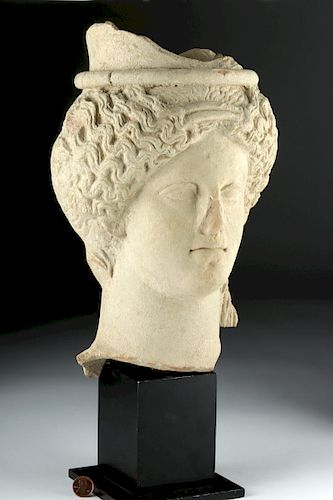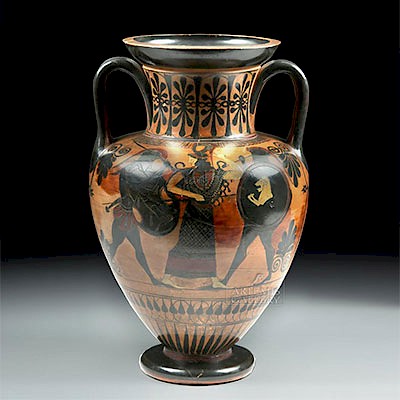Near Life-Size Sicilian Terracotta Head of Goddess TL'd
Lot 11b
About Seller
Artemis Fine Arts
686 S Taylor Ave, Ste 106
Louisville, CO 80027
United States
Selling antiquities, ancient and ethnographic art online since 1993, Artemis Gallery specializes in Classical Antiquities (Egyptian, Greek, Roman, Near Eastern), Asian, Pre-Columbian, African / Tribal / Oceanographic art. Our extensive inventory includes pottery, stone, metal, wood, glass and textil...Read more
Estimate:
$18,000 - $25,000
Absentee vs Live bid
Two ways to bid:
- Leave a max absentee bid and the platform will bid on your behalf up to your maximum bid during the live auction.
- Bid live during the auction and your bids will be submitted real-time to the auctioneer.
Bid Increments
| Price | Bid Increment |
|---|---|
| $0 | $25 |
| $300 | $50 |
| $1,000 | $100 |
| $2,000 | $250 |
| $5,000 | $500 |
| $10,000 | $1,000 |
| $20,000 | $2,500 |
| $50,000 | $5,000 |
| $100,000 | $10,000 |
| $200,000 | $20,000 |
About Auction
By Artemis Fine Arts
Oct 11, 2018
Set Reminder
2018-10-11 10:00:00
2018-10-11 10:00:00
America/New_York
Bidsquare
Bidsquare : Exceptional Antiquities | Ethnographic Art
https://www.bidsquare.com/auctions/artemis-gallery/exceptional-antiquities-ethnographic-art-3500
An important one-day auction featuring museum-worthy examples of classical antiquities, ancient and ethnographic art from cultures encompassing the globe. Artemis Fine Arts info@artemisgallery.com
An important one-day auction featuring museum-worthy examples of classical antiquities, ancient and ethnographic art from cultures encompassing the globe. Artemis Fine Arts info@artemisgallery.com
- Lot Description
Magna Graecia, Southern Italy, Sicily, ca. 4th century BCE. Breathtaking, to say the least! A finely sculpted head of a beautiful goddess, possibly Persephone or Demeter - presenting a delicate visage comprised of thickly-lidded, almond-shaped eyes, an aquiline nose, finely modeled facial planes, a rounded cleft chin, petite ears, and full, heart-shaped lips all upon a long, slender neck and crowned by an elaborate, centrally parted wavy coiffure with corkscrew tresses falling down the side of her neck, as well as a lovely polos. The piece has a reddish clay body that was finished in a milky white hue. The sculptor of this piece modeled the beautiful goddess of the harvest with the utmost sensitivity and skill. Size: 12.25" H (31.1 cm); 16.375" H (41.6 cm) on included custom stand.
The undeniable beauty of this piece deserves more gushing on my part. So here we go: She is depicted with her head almost perfectly erect but ever so slightly tipped to the right, her attractive coiffure, parted at the center and swept back, frames her forehead with painstakingly delineated wavy tresses that conjure waves of grain - apropos for a goddess of agriculture. The goddess' elegant, oval face is skillfully modeled so as to present a naturalistic visage with a rounded forehead, large doe eyes that were most likely once vividly painted so as to define the irises and pupils, a fine browline that arches gracefully and merges with the bridge of her nose, a soft rounded chin, and full, bow-shaped, pursed lips.
The worship of Demeter and Persephone was very popular in ancient Sicily - an island known for its agriculture that supplied grain to Magna Graecia. Demeter was revered as a goddes of agriculture, and in addition to her associations with the underworld, Persephone - queen of the underworld, daughter of Zeus and the harvest goddess Demeter, and wife of Hades - is also associated with spring as the vegetation goddess. Furthermore, Persephone and her mother Demeter were central figures in the Eleusinian mysteries. These were elaborate festivals that took place every five years. Unfortunately, scholars know little about them as those who attended the Eleusinian Mysteries were sworn to secrecy. This said, most agree that the central theme of these Mysteries was that just as the grain returns every spring following its harvest and the winter hibernatory period, the soul returns after the death of the human body, reincarnated for the next life. The Eleusinian Mysteries were not the only Mysteries of the Greco-Roman world. There were also the Mysteries of Dionysos depicted in a famous fresco just outside Pompeii at Herculaneaum (the so-called Villa of the Mysteries) as well as Mysteries of various imported eastern gods such as Sabazios and Isis.
For a reference, see a similar Sicilian head of Demeter (ca. 350 to 300 BCE) at the Getty Villa (inventory number 76.AD.34)
This piece has been tested using thermoluminescence (TL) and has been found to be ancient and of the period stated. A full report will accompany purchase.
Provenance: private Orange County, California, USA collection acquired before 2000
All items legal to buy/sell under U.S. Statute covering cultural patrimony Code 2600, CHAPTER 14, and are guaranteed to be as described or your money back.
A Certificate of Authenticity will accompany all winning bids.
We ship worldwide and handle all shipping in-house for your convenience.
#135097Losses to polos, neck, one banana curl and end of existing banana curl, nose, and other high pointed areas. Expected surface wear with scuffs/nicks to forehead and cheeks. The placement of the vent hole on the verso is unusual, as these are usually just vented at the base; however, this is not unprededented.Condition
- Shipping Info
-
All shipping is handled in-house for your convenience. Your invoice from Artemis Gallery will include shipping calculation instructions. If in doubt, please inquire BEFORE bidding for estimated shipping costs for individual items.
-
- Buyer's Premium



 EUR
EUR CAD
CAD AUD
AUD GBP
GBP MXN
MXN HKD
HKD CNY
CNY MYR
MYR SEK
SEK SGD
SGD CHF
CHF THB
THB















